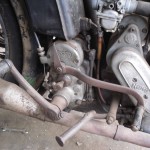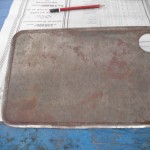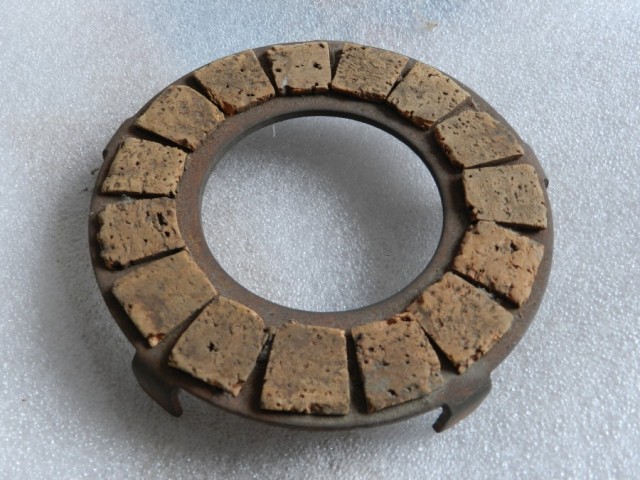This is pretty much the state of the Norton WD16H when it was acquired by Mr. Muthukumar. Now you know why the team at Riot Engine drops our collective jaw to the ground every time we receive a mail from Mr. Muthukumar.
Step One. Swap the tyres for new ones. Muthukumar believes this step to be so important that no time was wasted taking pictures of the old tyres. As soon as the bike was in his possession he had the tyres replaced for new ones. I wonder if it has something to do with seeing the iconic old lady in sad shoes. It has become common practice with some restorers to replace the front tyres of British classics with the ribbed kind seen on bullets. Not with Muthukumar. He argues that ribbed tyres were not yet invented when the 16H was in her prime. So he made sure he got the exact kind of tyres he wanted, the informally named ‘semi knobbies’.
Muthukumar started making a list of parts that would have to be procured. The motorcycle when acquired had a Villiers carburettor since that must have been the only spigot type carb available to the previous owner. The first task was to find an original Amal Carburettor. Muthukumar set off about the task, scouring the net and spreading word to friends and other acquaintances.
Meanwhile, he set about trying to get the engine started up. After some coaxing, the engine did fire up, but it was obvious that the engine was not performing optimally. The motorcycle was missing the Miller’s amp gauge and the Smiths speedometer. The speedometer drive and cable was also missing. The cable was procured from a dealer who had an unused old stock of the cable. The gears that drove the speedometer were a different story though.
Muthukumar had to obtain the specs of the gears used from an enthusiast in Austria, who obliged with some photographs. Muthukumar set about designing the spur gears that would drive the speedo and then handed over the task of milling these gears to a machinist. Now, with the drive in place, and the meter in hand, Muthukumar was left with the task of finding the exact shape of the metal mounting bracket for the speedometer. During a visit to a friend in a South Indian city, he managed to locate another Norton, created a template of the metal bracket and then returned home to the task of fabricating this piece. Riot Engine bows down to the effort this gentleman puts into ensuring even the simplest details are not overlooked.
When making a list of the parts to be procured, Muthukumar noticed that the rear number plate had been borrowed from a Royal Enfield Twin Port. Saving up the plate for another day, when he probably would own a Twinport or maybe be in a position to help out an acquaintance looking for such a number plate, he shifted his attention to procuring the authentic plates for the Norton ( pictured above).
The rear mudguard in the Norton has a detachable tail piece, which enables easy tyre removal. This tail piece was damaged, and another one had to hunted down. After finding this piece and transporting it back home, Muthukumar realized this one wasn’t in good condition either and had to take up repair of the original part.


The front mudguard was twisted and the rear, had been worn down by the tyre rubbing on it for a considerable number of miles. These were fixed and primed for painting.


The toobox was missing the lock, which had to be fabricated taking the lock on the tappet cover as a reference. This type of lock was called the Winged ‘Gravity’ Knob.
Girder Fork, Upholstery, Saddle Bags, Panniers


The girder fork , meanwhile was screaming for attention, with one of the rebound springs and the connecting extensions and a fork tube bent laterally. The handlebar had fared no better. The bolts in the front fork assembly were completely worn, some missing and were of the DTW standard. The bent components were fixed, and the bolts fabricated.

The cotters holding the springs in place were also worn. Rather than fabricate new ones, Muthukumar resorted to metal spraying, which though expensive, retains the properties of the components, and also gives the restorer the satisfaction of having retained an original component.
Metal spraying is the process of spraying hot metal on to a surface by melting the metal (pure or alloyed) in a flame, which is then subjected to a blast of compressed air that creates tiny droplets of molten metal and projects the droplets towards the surface to be coated. The built-up area can then be ground or machined to very fine tolerances, in order to produce a repaired component which is often better than the original. This method is best employed in situations where mechanical wear rather than irreparable damage is the problem.
A component in the kicker mechanism, which obviously has had a lot of wear and tear, was repaired by this process. In a world, where compromise is a way of life, one cannot help but wonder, how Muthukumar goes that extra mile, with no hesitation.
The steering bearing races had to be polished, and some missing balls replaced.
The brakes were shot. Again, off the shelf consumables for a motorcycle like the 16H are hard to come by. Loose lining was bought, an adhesive solution used to stick it to the old shoes, then the asbestos ground to the required dimensions.
The main stand was in a bad shape, a couple of hours more went into fixing it.


The panniers at the rear, used to carry luggage needed some work. Now, it would be normal for us to assume that fixing this structure of metal would mean some welding, some grinding and some painting. No. These panniers were connected to the frame with rivets and some winged bolts. So Muthukumar set out to find some of these winged bolts which you can see in some of the pictures. When you sit down and have a closer look, I have to say, it is these details that tell you more about the motorcycle than the decals.
The seat frame and the ‘sling’ springs inside the seat were mended and the upholstery done. The tan material you see used for the seats is Camel Leather. These seats though, had to be discarded since the contours of the rear seat were not perfect. Muthukumar then had these seats redone with blackleather, which you’ve seen on the motorcycle.
This 16H’s prop stand was missing when it was acquired by Muthukumar. The prop stand is a tapering solid block of forged steel that couldn’t be fabricated simply by turning in a lathe. So Muthukumar had a prop stand forged, using a component from a Lambretta autorickshaw to explain the complex form required to the machinist.
As is often the case, after having successfully fabricated the prop stand, Muthukumar chanced upon a Norton prop stand from an acquaintance, which was then duly repainted and fitted onto the WD16H. Muthukumar nonchalantly tells this isn’t something you crib about. He just takes it in stride, and moves onto the next phase.

Engine & Transmission
Then engine and transmission were then diassembled to replace worn parts. The gearbox had a chunk of metal dislodged, which had to fixed by welding. A bearing mounted on the top gear rod had given up and had to be replaced. It was then Muthukumar realized that the bearing was of a ‘floating’ kind that allowed for slight play along the axis of the rod, and such bearings were not available locally. Another acquaintance helped procure the bearing, a Swedish SKF make.


Muthukumar also decided to swap the piston for a new Hepolite Piston brought down from the UK. The exhaust can was in good shape and needed just a little fixing up, whereas the exhaust pipe was completely damaged and had to to be fabricated.
The Clutch Plates for the Norton and various other bikes and cars of that period used cork to provide the friction necessary to transmit power. Back then, re-corking the plates would have been but a simple task. Now though, you need to as resourceful as Muthukumar, procuring cork from bottle recyclers, ( who have a colloquial numbering system for corks of various sizes) and then machining them to the required dimensions. Muthukumar recommends soaking the cork in water, which makes it flexible enough to be pushed into the openings in the clutch plate.
The crankcase, also has a shield, probably to protect the underside from the unforgiving terrain. Muthukumar also brings to my notice that the tank, has relatively thick sheet metal probably to protect the fuel tank in the event of a crash, whereas the rest of the components have a higher gauge ( less thickness), compared to other British motorcycle of that period. Muthukumar suggests, this was probably done with intent to keep the motorcycle lighter.
The insulation for the wiring in the British singles of that period were of the cloth type. Some restorers prefer to use a synthetic lookalike that does the job. Muthukumar didn’t have any such inclination, he preferred a good quality PVC wiring which was then covered up with dyed cloth tape that gives pretty much the same results. Come to think of it, this method, where the restorer puts in more effort to achieve the required result must be more fulfilling than simply slapping on a synthetic substitute he knows is meant to decieve and do nothing much else.
Some components were chromed, some given a cadmium coating and the matt paint with just a hint of gloss, chosen after a lot of trial and error was sprayed and the machine restored to its glory days.
There is one bit of information regarding the engine rebuild that I’d purposely pushed to the end of this page. Muthukumar had procured a ‘new’ old stock crankpin and even though the one in the engine was worthy of operation, he replaced it. He says, the joy and thrill of finding an original component and replacing it in the motorcycle is unparalleled. After having spent time listening to him recount the restoration process, being led through the roller coaster of emotions he rode through, I wonder if I even have the right to disagree, if I wanted to. I’m left in as much awe as I was before being acquainted with the Norton. I realized that with classics like these, a sense of familiarity doesn’t do much to diminish the respect nor the awe you have for the motorcycle. I would also extrapolate this realization to the man, Mr. Muthukumar.
Though I’ve removed the ‘Mr.’ for the convenience of writing, I simply cannot picture myself being on a first name basis with him. Neither can I drop the ‘Sir’ when in conversation. I bet the Queen herself would not want me to.






















